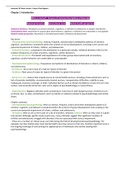Summary
Korte Samenvatting Disorders of Childhood: Development and Psychopathology, ISBN: 9781337515115 Developmental Psychopathology
- Course
- Institution
- Book
Een korte samenvatting van het boek 'Disorders of Childhood' van elk hoofstuk met diagram, belangrijke begrippen en korte samenvatting. Belangrijke begrippen in het groen. Zie andere upload voor een uitgebreide samenvatting per paragraaf. A short summary of the book 'Disorders of Childhood' of ...
[Show more]



